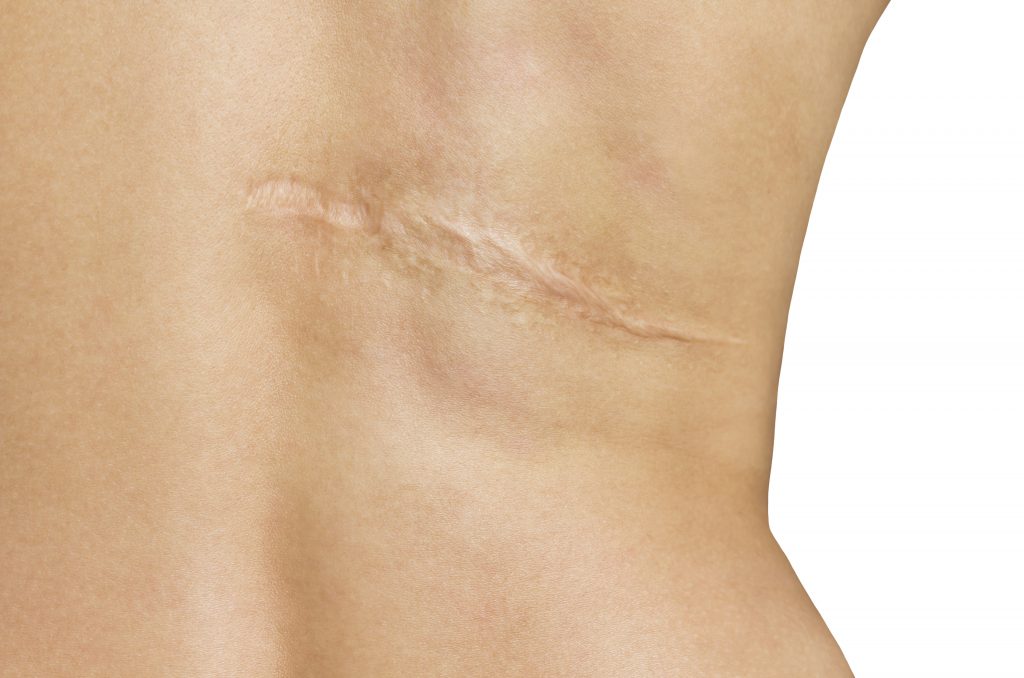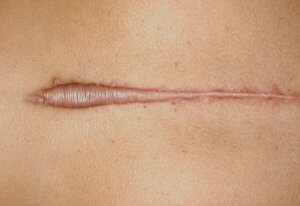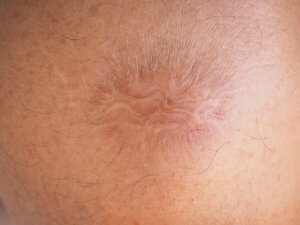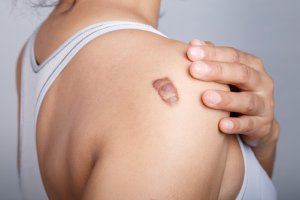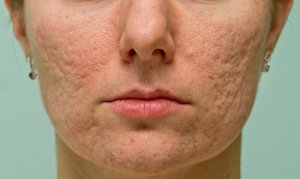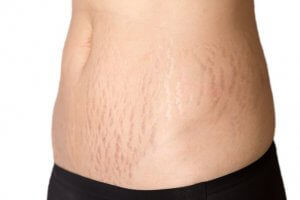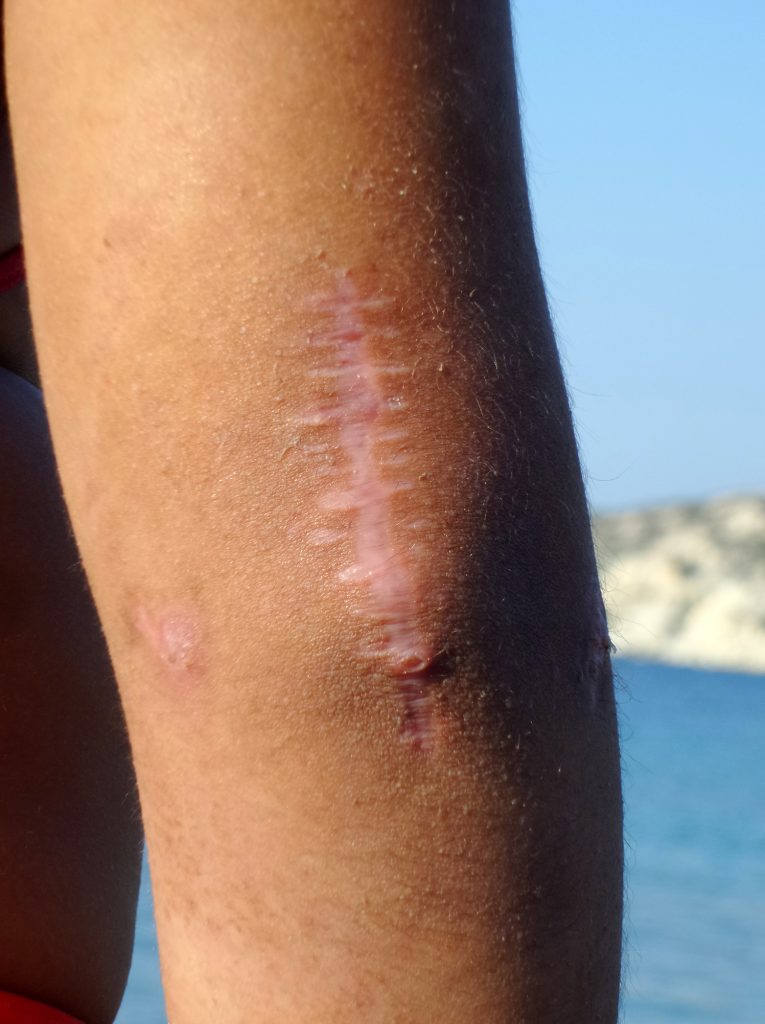Scar Treatments & Revisions at U.S. Dermatology Partners
Understanding Scar Development & How to Address These Skin Flaws
We all want healthy, beautiful skin. But scars, a natural part of the healing process, leave a lasting mark and cause some people to struggle with the negative impact on the appearance of their skin and in some cases, limitations in function or other concerns. If you’re unhappy with the appearance, texture, or health of your skin after an injury, surgery, or other damage that leads to scarring, the U.S. Dermatology Partners team can offer treatment to improve the appearance of scarring.
Find This Service Near You
What Are Scars?
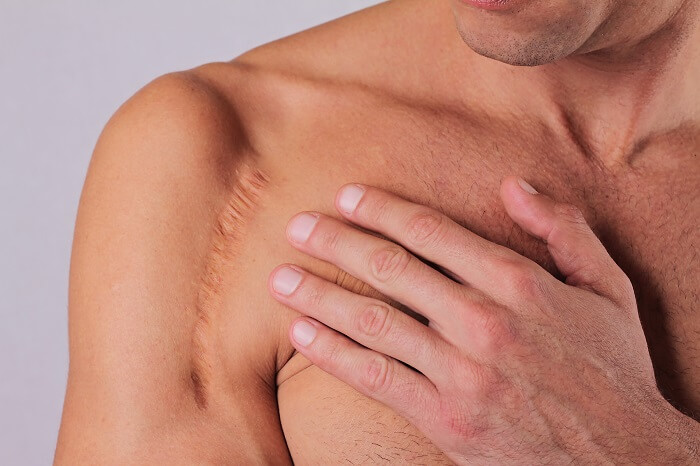
The skin is our body’s largest organ, and the role of the skin is to protect the body from external dangers or irritants. When the skin is damaged by a traumatic accident, injury, burns, acne, illness, or other cause, the result is the formation of new skin cells and tissues to repair the structure and restore skin to its natural purpose, protecting the body. When damage only affects the outer layer of skin, the epidermis, you may not see scar formation. When skin damage penetrates deeper, reaching the dermis tissue, scarring is likely to occur. The surface of the skin is very thin, and we’re constantly shedding these cells and replacing them with new ones, so when a cut or scrape only damages those exterior cells, the odds are good that there won’t be any permanent scarring. When damage reaches the interior dermis layer, new collagen fibers need to be created to knit the skin back together. The new skin is often a different color and texture than surrounding tissue, which is what we call scar tissue.
Are There Different Types of Scars?
Dermatologists use different names to identify scars that share a specific set of characteristics. Scars are a natural part of the healing process and can result from inflammation such as acne, infection, injury, or surgery.
Some common types of scars include:
Hypertrophic Scars
Hypertrophic scars are the most common type of scar. These scars are raised above the natural surface of the skin directly over the wound site. Tissue develops over the course of weeks after the initial injury and will remain within the borders of the wound. Hypertrophic scars may appear red and raised next to healthy skin and will sometimes fade naturally. Though this type of scar tissue is often red in color, coloring can actually be darker or lighter than the natural skin tone.
Contracture Scars
Contracture scars are formed after the skin is burned. Unlike other types of scar tissue that is just the body’s attempt to repair and replace damaged skin, contracture scar tissue is often much tighter and less movable than surrounding tissue. It can even impact muscle and nerve function, limiting your range of motion.
Keloid Scars
Keloid scars may appear as irregular clusters of tissue that form a thick, rounded lesion. A keloid scar extends beyond the original boundaries of the wound, can develop as long as 12 months after the initial injury, and may be darker than surrounding skin. These scars are caused by an overactive healing response that creates scar tissue that extends far beyond the original wound. Common among people of color, this type of scar development may be prevented in some cases with the proper use of compression garments, especially in higher-risk patients.
Atrophic Scars
Atrophic scars are well-defined depressions in the skin and are the result of a disruption in the formation of collagen after a skin injury. This scar tissue causes pits or indentations in the surface of the skin and is commonly caused by acne, cystic acne, or chickenpox. Not everyone with acne develops scars, and there are preventive measures you can take to limit scarring from acne, including following your dermatologist’s skincare recommendations and avoiding picking or popping pimples. Cystic acne and other types of acne that form cysts and pustules deep within the skin’s layers are much more likely to cause scarring.
Stretch Mark Scars
Stretch marks appear due to the rapid production of new skin cells. Common among pregnant women, those who gain weight quickly, and those who experience a rapid growth spurt. Stretch marks also develop if a skin injury occurs at a joint.
Who Would Need Scar Treatment or Revision?
Scar treatments and revisions are used to address specific side effects of scarring. Specifically, scar treatments may be used to improve the cosmetic aspects of scarring, including:
- Erythema (redness)
- Hypopigmentation (lighter skin)
- Hyperpigmentation (darker skin)
Scar treatment or revision may also address changes in the way skin feels, including:
- Textural changes
- Atrophy (sunken skin)
- Hypertrophy (thickness)
Finally, your dermatologist may recommend treatment or revision for scars that cause functional concerns or discomfort. Contractile healing after burns can result in skin tightening and impaired function. When this occurs, we may need to provide intervention to improve functionality and avoid long term issues. Some scar tissue can cause dysesthesia, which is a condition caused by nerve damage that leads to symptoms like pain, itching, and numbness. In some cases, we can address the nerve damage and improve associated symptoms.
What Scar Treatments are Available?
Each person will respond differently to scar treatments, but scar tissue will seldom completely disappear. However, there are many options available that can address common side effects of scarring and improve appearance, including:
- Laser Treatments – may be used to remove redness, uneven tone, and differing textures, including thickening and contracture, from scar tissue formation.
- Bleaching – topical bleaching agents may be applied to areas with hyperpigmentation to lighten them, so they blend more closely with the surrounding tissue.
- Injectable Fillers – for atrophic scars caused by acne or chickenpox, we may be able to use dermal fillers to restore the smooth, fullness of skin.
- Chemical Peels – for skin texture and tone irregularities, chemical peels can help to smooth out the appearance.
- Radiofrequency Microneedling – like chemical peels, these treatments can help to remove skin irregularities caused by scarring and restore a healthy, even skin tone and texture.
- Steroids – injected steroids may impact the production of collagen, which will change the appearance and amount of scar tissue, especially beneficial for raised scars.
- Fluorouracil (5FU) – used to address raised or thick scar tissue to create more natural-looking and feeling skin.
How are Scar Revisions Performed?
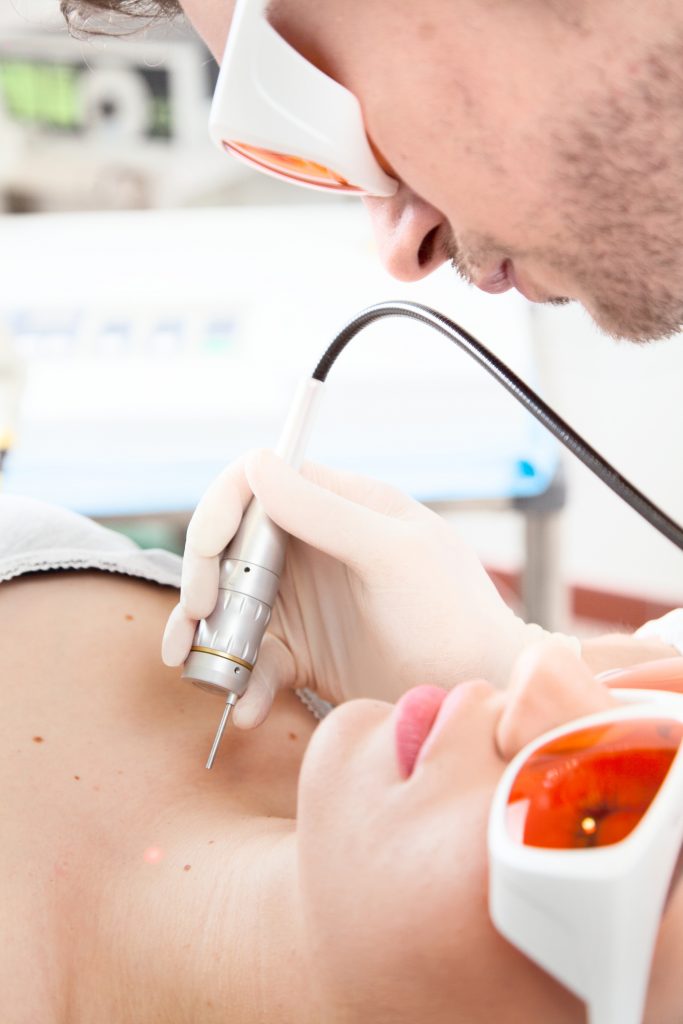
CO2 laser restoration is a common treatment for scars.
If your scar does not fade on its own, it may be treated with dermatologic care. Your treatment will depend on many factors including the type of scar, your skin type, your age, and the location of the scar.
Certain scars respond to topical solutions that work by encouraging collagen production. Laser treatments or exfoliating treatments such as chemical peels and microdermabrasion may also be effective in reducing the appearance of scars.
The most common scar treatments are:
- Use of an ablative laser known as CO2 laser restoration that stimulates new, healthy collagen to grow and fill the depressed pockets of skin. In some cases, this will be combined with dermal filler injections.
- Pulse-dye lasering, known as Candela or Cynosure lasering, which uses concentrated beams of heat to soften and flatten the excess collagen that makes up these scars.
Revision is the process of redoing something with the hopes of improving the end result. Scar revision is no different. This treatment for scarring involves surgically removing scar tissue and closing the wound differently to improve the final appearance of the skin after healing. Scar revision is typically only recommended after other, less invasive treatment options have been considered.
There are a few surgical scar revision options that can improve skin health and appearance, including:
- Skin grafts – skin removed from one part of the body (or from a donor) is used to cover and repair the damaged skin.
- Skin flaps – rather than just the outer layer of skin used for grafting, skin flaps use deeper layers of skin with their own blood supply placed over a wound to improve the appearance of skin after healing.
- Z-plasty – this procedure involves making new incisions in the skin to change the direction or position of scar tissue, relieve skin tension, and decrease the visibility of scar tissue.
The doctors at U.S. Dermatology Partners can help you find the best type of laser treatment for your specific type of scar.
Are There Side Effects to Scar Treatments?
While results vary from person to person, people of ethnic background, such as Asians and African-Americans, face a greater risk of altered pigment after any type of laser treatment.
How Long Will Scar Treatments Last?
Certain scars respond differently to different treatments. How long the effects of your treatment last depend on the type of scar and the response of the scar to treatment.
Can You Prevent Scarring?
The number one way to prevent scarring is to talk to your dermatologist about the injury or other causes of scarring right away. In most cases, damage that reaches the dermal layer of the skin will leave a scar, but your dermatologist can help you minimize the appearance of the resulting scar tissue. While your specific skincare plan will differ depending on the cause of scarring, you may want to take the following steps to limit your risk for scarring:
- Always keep wounds clean by washing and disinfecting regularly. However, avoid rubbing or pulling at healing skin, which can reopen the wound, cause additional inflammation and irritation, and increase the risk for scarring.
- Use petrolatum products (petroleum jelly) to protect the skin and promote healing. Petrolatum also keeps injured skin moisturized, preventing scabbing that can slow healing and increase the risk for noticeable scarring.
- Keep the wound covered. Use gauze, hydrogel pads, or silicone dressings to protect the skin, keep the injury moisturized, and promote healing. You should change your bandages and clean your wound regularly.
- Use compression garments as directed by your dermatologist, surgeon, or other medical professionals to promote good circulation, minimize inflammation, and speed healing time.
- If you have acne-prone skin, avoid popping pimples or picking at your skin as this increases your risk for infection and scarring.
- If you have sensitive skin, frequently have allergic reactions, or you’re struggling with systemic conditions that impact the skin (chickenpox), don’t scratch. Instead, use cold compresses, colloidal oatmeal baths, anti-itch creams, and other interventions to address itching.
*Results may vary by individual

